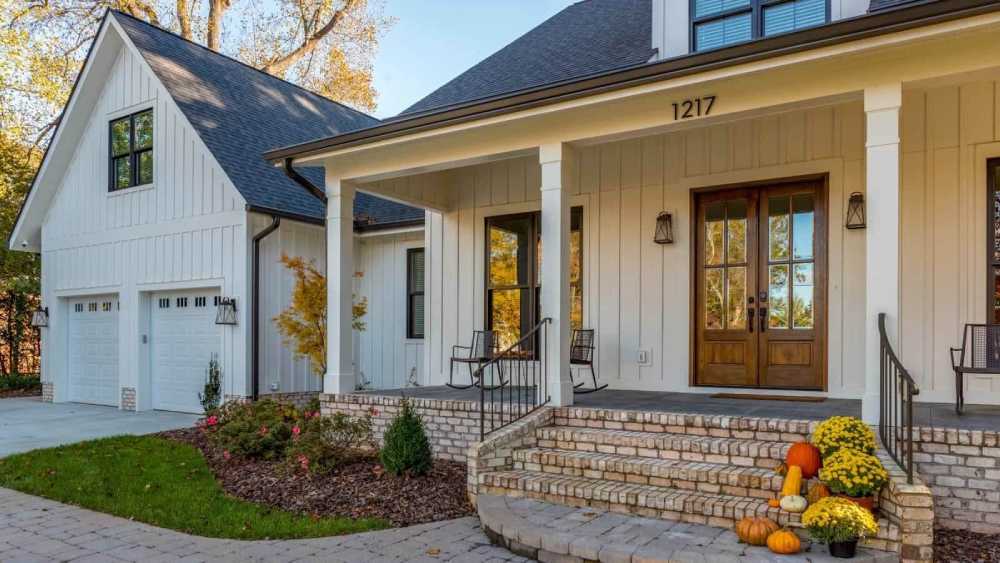The Timeless Appeal of Wooden Entry Doors
Wooden entry doors have been a staple in home design for centuries, offering a distinctive blend of beauty and durability. Whether you’re going for a rustic, classic, or modern look, wood doors provide a versatile option that can match any aesthetic preference. These doors do not just serve as entrances but also make a powerful design statement.
The natural grains and textures of wood bring a warmth and organic feel that other materials simply cannot replicate, making it a perpetual favorite in architectural design.
Contents
Benefits of Choosing Wooden Doors
The inherent beauty and customizability of wooden doors are two of its main benefits. They can be made to fit any doorway and have excellent insulating qualities. A recent article in Architectural Digest claims that wooden doors are still popular because of their adaptability and classic charm.
Wooden doors are distinctive and visually arresting features of interior design because of their natural textures and deep colors. Wooden doors may also be painted, stained, or carved in a variety of ways to fit any style that is wanted. They are perfect for high-traffic locations such as entryways since they are highly resilient and can tolerate substantial wear and tear.
Wood can be readily polished and mended, unlike other materials, which prolong its life and keep its beauty over time.
Types of Wood Used in Entry Doors
There are several types of wood commonly used in crafting entry doors, each offering unique characteristics and advantages. The choice of wood can drastically affect both the appearance and performance of the door. Some popular options include:
- Mahogany: Known for its durability and rich color, Mahogany is a premium choice for wooden doors. This hardwood resists rot and insects, making it suitable for exterior use. Its deep, reddish-brown color adds a touch of luxury and sophistication to any home.
- Oak: Oak is prized for its strength and prominent grain, making it both a sturdy and visually appealing option. Available in red and white varieties, oak can be stained to various shades, enhancing its natural beauty. Its robust structure ensures that it can handle heavy use without succumbing to wear and tear.
- Walnut: Walnut provides a dark, sleek look and is often used in high-end designs. Its delicate, straight-grain and rich, chocolate-brown color make it a favorite among designers looking for a sophisticated, modern aesthetic. Walnut is also incredibly durable, making it ideal for long-lasting installations.
- Cherry: Cherry wood has a smooth texture and a warm, reddish color that grows richer with age. It’s known for its fine grain and lustrous finish, often darkening to a deep, reddish hue over time. This characteristic adds depth and character, making cherry wood doors a lasting investment in home elegance.
Design Variations
From intricate carvings to minimalist designs, wooden doors offer a myriad of design possibilities. The flexibility in design makes them suitable for various architectural styles, whether traditional or contemporary.
Homes & Gardens magazine highlights that the choice of stain and finish can significantly enhance a door’s visual appeal and durability, allowing homeowners to tailor their entryways to their tastes. Modern design trends often incorporate glass panels, metal accents, and unique hardware to complement the wood’s natural beauty. These combinations create eye-catching entrances that make a lasting impression.
For those preferring a more classic appeal, traditional panel designs with ornate carvings can be chosen to showcase craftsmanship and timeless elegance. Custom wood doors can be designed to fit any size or shape of the entryway, offering bespoke solutions for unique architectural needs.
Maintenance Tips for Wooden Doors
Wooden doors require regular maintenance to prevent damage from moisture and UV rays. This includes cleaning the door surface with mild detergent, applying a fresh coat of sealant or paint, inspecting for cracks or warping, and using weatherstripping to enhance insulation and prevent drafts.
Regular cleaning helps remove dust and grime while applying a fresh coat, which protects against environmental damage. Early detection of damage can prevent severe problems and extend the door’s lifespan. Simple repairs like filling cracks or reinforcing weak spots can significantly improve the door’s appearance. Proper weatherstripping also reduces the risk of swelling and rot.
How to Choose the Right Wooden Door
When selecting a wooden door, consider factors such as the door’s exposure to the elements, the overall design of the home, and your budget. It’s wise to consult with a professional to determine the best type of wood and finish for your specific needs.
For instance, if you live in a region with high moisture levels, choosing a wood type that withstands humidity better can be a smart move. Mahogany and cedar are excellent choices for humid environments due to their resistance to rot and moisture-related damage. For those in colder climates, a well-insulated oak or maple door can help retain heat and reduce energy costs.
Additionally, consider the door’s thickness and construction quality, as these factors contribute to its overall durability and security. Investing in a high-quality, well-constructed door ensures long-term satisfaction and performance.
Cost Considerations
While wooden doors can be more expensive than other materials, they offer long-term value and aesthetic benefits. It’s important to factor in both the initial cost and the long-term maintenance expenses when making a decision. Wooden doors often require some upkeep, which can include periodic resealing and refinishing to maintain their appearance and structural integrity.
However, the investment can pay off in increased home value and curb appeal. High-quality wooden doors also enhance home security, offering a substantial barrier against potential intruders. Furthermore, the ability to repair and refinish wooden doors means they can be restored to their original beauty even after years of use, unlike many composite or metal doors that may not offer the same longevity and adaptability.
The rich, natural look and feel of wood can significantly enhance the overall aesthetic and marketability of your home, making it a worthwhile investment for discerning homeowners.
Conclusion
Wooden entry doors remain a popular choice for homeowners due to their timeless beauty and practical benefits. By understanding the different types of wood, maintenance requirements, and cost considerations, you can make an informed decision that enhances the value and aesthetic appeal of your home.
Whether you’re renovating an old home or constructing a new one, a well-chosen wooden door can add elegance and lasting charm to your entryway. The blend of natural aesthetics, customization options, and robust performance makes wooden doors a superior choice for those seeking to create an inviting and enduring entryway.

